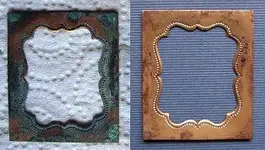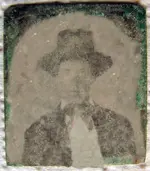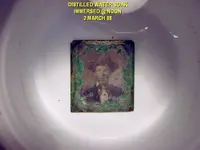Don, that is just awesome. The photo itself, the cleanup of the frame, the works. Just tremendous.
On the page that someone posted
(
http://infoshare1.princeton.edu/libraries/firestone/rbsc/mudd/online_ex/dags/conserve/electro.shtml ) it mentions that they use "ammonium hydroxide" - Is that the same thing as plain ol' ammonia? And then they put it through several "solvent baths" - but they don't say what solvent they use.
I wonder if that solvent they use is something that makes the ammonia/ammonium hydroxide inert - to stop any further chemical reaction. You might wanna find a chemist - surely there's someone here on TNet! - that could put his/her 2¢ in on that.
Something that occurs to me about using ammonia - there's a "natural dye" mixture that some weavers have used that involves using ammonia (and water) with a foot of copper pipe placed in it. Depending on the strength of the ammonia, and how long it sits, the copper actually dissolves - making a spiffy dye for wool or cotton.
But the copper dissolves!
Now, what the weaver does to make the dye stuff environmentally safe to pour out (sorta neutralize the ammonia), is simply add an egg to the solution and stir it in. When it turns black, it's safe to pour down the drain or wherever. Maybe some kind of solution using an egg stirred into water would be the equivalent to that unnamed "solvent" - ? Dunno. Maybe experiment first using older pennies?
Anyway, awesome find, and I'm really looking forward to seeing the transformation,
HH
Nan





 I hope
I hope  who lived there....he sure was a handsome fella! Looks to be somewhere about mid-20's...(Maybe in the age range of 18-25)
who lived there....he sure was a handsome fella! Looks to be somewhere about mid-20's...(Maybe in the age range of 18-25) I hope I can find something like that in the future!!!
I hope I can find something like that in the future!!!

 I feel confident the distilled water bath is the next step, hopefully stabilizing any corrosion before I proceed with any procedure after that, which right now I am thinking of a 4 parts distilled water to 1 part Ammonia bath. If that goes well but does not remove enough of the copper chlorides (blue/green junk) I will then increase the Ammonia to 50/50 as I had with the copper mat plate and outside cover.
I feel confident the distilled water bath is the next step, hopefully stabilizing any corrosion before I proceed with any procedure after that, which right now I am thinking of a 4 parts distilled water to 1 part Ammonia bath. If that goes well but does not remove enough of the copper chlorides (blue/green junk) I will then increase the Ammonia to 50/50 as I had with the copper mat plate and outside cover.

